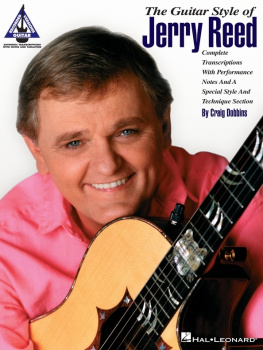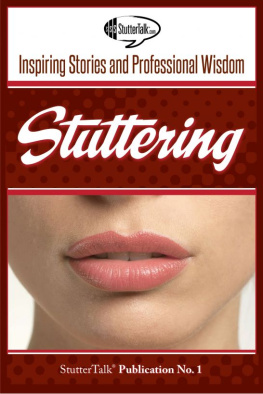Guitar - Stuttering : An Integrated Approach to its Nature and Treatment
Here you can read online Guitar - Stuttering : An Integrated Approach to its Nature and Treatment full text of the book (entire story) in english for free. Download pdf and epub, get meaning, cover and reviews about this ebook. year: 2018, publisher: Wolters Kluwer Health, genre: Children. Description of the work, (preface) as well as reviews are available. Best literature library LitArk.com created for fans of good reading and offers a wide selection of genres:
Romance novel
Science fiction
Adventure
Detective
Science
History
Home and family
Prose
Art
Politics
Computer
Non-fiction
Religion
Business
Children
Humor
Choose a favorite category and find really read worthwhile books. Enjoy immersion in the world of imagination, feel the emotions of the characters or learn something new for yourself, make an fascinating discovery.
Stuttering : An Integrated Approach to its Nature and Treatment: summary, description and annotation
We offer to read an annotation, description, summary or preface (depends on what the author of the book "Stuttering : An Integrated Approach to its Nature and Treatment" wrote himself). If you haven't found the necessary information about the book — write in the comments, we will try to find it.
Guitar: author's other books
Who wrote Stuttering : An Integrated Approach to its Nature and Treatment? Find out the surname, the name of the author of the book and a list of all author's works by series.
Stuttering : An Integrated Approach to its Nature and Treatment — read online for free the complete book (whole text) full work
Below is the text of the book, divided by pages. System saving the place of the last page read, allows you to conveniently read the book "Stuttering : An Integrated Approach to its Nature and Treatment" online for free, without having to search again every time where you left off. Put a bookmark, and you can go to the page where you finished reading at any time.
Font size:
Interval:
Bookmark:
An Integrated Approach to Its Nature and Treatment
An Integrated Approach to Its Nature and Treatment
BARRY GUITAR, PhD
Professor
Department of Communication Sciences
University of Vermont
Burlington, Vermont

Acquisitions Editor: Matt Hauber
Development Editor: Amy Millholen
Editorial Coordinators: Andrea Klingler and Kerry McShane
Editorial Assistant: Parisa Saranj
Production Project Manager: Kim Cox
Marketing Manager: Jason Oberacker
Designer: Stephen Druding
Artist: Bot Roda
Compositor: SPi Global
5th Edition
Copyright 2019 Wolters Kluwer
Copyright 2014 Lippincott Williams & Wilkins, a Wolters Kluwer business. Copyright 2006 by Lippincott Williams & Wilkins. Copyright 1999, 1991 by Williams & Wilkins. All rights reserved. This book is protected by copyright. No part of this book may be reproduced or transmitted in any form or by any means, including as photocopies or scanned-in or other electronic copies, or utilized by any information storage and retrieval system without written permission from the copyright owner, except for brief quotations embodied in critical articles and reviews. Materials appearing in this book prepared by individuals as part of their official duties as U.S. government employees are not covered by the above-mentioned copyright. To request permission, please contact Wolters Kluwer at Two Commerce Square, 2001 Market Street, Philadelphia, PA 19103, via email at (products and services).
9 8 7 6 5 4 3 2 1
Printed in China
Library of Congress Cataloging-in-Publication Data
Names: Guitar, Barry, author.
Title: Stuttering : an integrated approach to its nature and treatment / Barry Guitar.
Description: Fifth edition. | Philadelphia : Wolters Kluwer, [2019] | Includes bibliographical references and index.
Identifiers: LCCN 2018049600 | ISBN 9781496346124 (paperback)
Subjects: | MESH: Stutteringtherapy | Stutteringetiology | Stutteringdiagnosis
Classification: LCC RC424 | NLM WM 475.7 | DDC 616.85/54dc23 LC record available at https://lccn.loc.gov/2018049600
This work is provided as is, and the publisher disclaims any and all warranties, express or implied, including any warranties as to accuracy, comprehensiveness, or currency of the content of this work.
This work is no substitute for individual patient assessment based upon healthcare professionals examination of each patient and consideration of, among other things, age, weight, gender, current or prior medical conditions, medication history, laboratory data and other factors unique to the patient. The publisher does not provide medical advice or guidance and this work is merely a reference tool. Healthcare professionals, and not the publisher, are solely responsible for the use of this work including all medical judgments and for any resulting diagnosis and treatments.
Given continuous, rapid advances in medical science and health information, independent professional verification of medical diagnoses, indications, appropriate pharmaceutical selections and dosages, and treatment options should be made and healthcare professionals should consult a variety of sources. When prescribing medication, healthcare professionals are advised to consult the product information sheet (the manufacturers package insert) accompanying each drug to verify, among other things, conditions of use, warnings and side effects and identify any changes in dosage schedule or contraindications, particularly if the medication to be administered is new, infrequently used or has a narrow therapeutic range. To the maximum extent permitted under applicable law, no responsibility is assumed by the publisher for any injury and/or damage to persons or property, as a matter of products liability, negligence law or otherwise, or from any reference to or use by any person of this work.
shop.lww.com
Stuttering is an intriguing and mysterious disorder. In the past 50 years, we have learned many secrets about what is different in the brains of those of us who stutter. Yet many unanswered questions remain. For example, we dont know exactly how these brain differences result in the speech disfluencies that we see in the onset of stuttering in children. We also dont know how the usually mild beginnings of stuttering becomefor some childrensevere, struggled behaviors accompanied by avoidance and emotional turmoil.
This book is an attempt to present the latest scientific findings and theoretical perspectives and integrate them with the best clinical approaches for evaluating and treating stuttering. As I worked on this new edition, I realized that my current thinking has been influenced deeply by my own stuttering therapist, Charles Van Riper, who summarized his final thoughts (1990) about stuttering in this way:
- Stuttering begins when the brain mistimes the complex movements required for fluent speech.
- The childs responses to these mistimings are the repetitions and prolongations that we observe as stuttering begins.
- Most children recover from stuttering because of maturation or because they do not react to their lags, repetitions, or prolongations by struggle or avoidance (Van Riper, 1990, 317 [italics mine]).
- The struggle and avoidance are learned and can be modified, although the mistimings are always there.
Some of my thinking in this edition focuses on the children who do not recover because they do react to their repetitions and prolongations. I view our therapies for preschool children as preventing these struggle and avoidance reactions and minimizing the stuttering they would be reacting to. We do this by helping them feel ok about their stuttering and teaching them how to talk more fluently. I also think that once the struggle and avoidance reactions are learned, they can be modified by reducing the (nonconscious) threat and (conscious) fear of stuttering that trigger these reactions. A combination of a strong, supportive client-clinician relationship and a program of reducing fear and shame, and confronting and tolerating the moment of stuttering to reduce tension, and then easing out of it will diminish struggle and avoidance. The resulting experience of feeling in control of stutters will further reduce maladaptive behaviors and negative feelings.
Have I anything more to say? Yes. I hope if you have suggestions for improving the next edition of this text, youll let me know.
Barry Guitar
bguitar@med.uvm.edu
Thank you to all my clients and students. You taught me as much as I taught you.
And thanks to my colleagues in Communication Sciences and Disorders and in Psychological Sciences whose writings and conversations, in person and via e-mail, have helped me become woke.
A round of applause for Andrea Klingler, Mike Nobel, Kerry McShane, and Amy Millholen, whose editorial talents made this book what it is.
Cheers for Bot Rodathe talented illustrator who gave life to all my notions about what might be helpful to put in visual form.
Kudos to Adinarayanan Lakshmanan Sivakumar (Siva) and his team who have done a wonderfully thorough job of compositing my manuscript into the printed page.
Hooray! Rebecca McCauley and Charlie Barasch, who have edited each chapter, making them more readable, updated, and cogent than my original drafts.
Font size:
Interval:
Bookmark:
Similar books «Stuttering : An Integrated Approach to its Nature and Treatment»
Look at similar books to Stuttering : An Integrated Approach to its Nature and Treatment. We have selected literature similar in name and meaning in the hope of providing readers with more options to find new, interesting, not yet read works.
Discussion, reviews of the book Stuttering : An Integrated Approach to its Nature and Treatment and just readers' own opinions. Leave your comments, write what you think about the work, its meaning or the main characters. Specify what exactly you liked and what you didn't like, and why you think so.









